Volume 1 Issue 1 (2008) DOI:10.1349/PS1.1938-6060.A.285
Toward A Visceral Scholarship Online:
Folkvine.org and Hypermedia Ethnography1
Craig Saper
-- for Chantale Fontaine, the heart of folkvine, 1980-2007
e-Media studies have focused increasing attention on online interactive fiction (including games, hypertext, and digital art), and, in recent years, academics have realized the importance of online venues for increased accessibility, decreased printing and distribution costs, and intensified visual and aural information for nonfiction and ethnography.2 The recent book Electronic Literature by N. Katherine Hayles, and an on-line collection edited by Hayles and others, serve to culminate a lineage of theory and criticism about electronic fiction and its consequences, and responses to changes in readers' types of attention (deep- to hyper attention).3 In terms of e-Media's importance for ethnography, an increasing group of visual anthropologists advocate using e-Media at least as a supplement to print-based and lecture-based instruction.4 Nevertheless, in the production of online scholarship, traditional print forms usually guide the production rather than hypermedia theories. This is a very different situation than the production of electronic and interactive fiction works. Johanna Drucker explains that "humanities computing has had very little use for analytic tools with foundations in visual epistemology. In this respect humanities computing follows the text-based (dare I say – logocentric?) approach typical of traditional humanities."5 Instead of employing any unique e-Media advantages, scholars have embraced electronic publication usually because e-Media can easily "reproduce printed text forms."6 Especially in fields focused on cultural analysis and conservation, the practices have not yet caught up with the theories. For example, online ethnographic websites must appeal to scholars in visual anthropology that often do not even consider visceral multi-sensory experiences as legitimate forms of scholarship.7 Even visual media has found little traction among those worried about the value of electronic forms.8 Theories of interface have many insights,9 but few of these theories have found applications in scholarship including ethnographic websites.10
Within that context, in which ethnographic studies of art and culture have traditionally found legitimation in print-based forms, Folkvine.org attempts to demonstrate design approaches, and scholarly methods, that serve the needs of three different audiences. First, the website seeks to serve a general-public looking for greater access to often inaccessible folk life and art. Second, it appeals to folklorists and ethnographers looking for scholarly studies of folk life. Third, and most relevant to this essay, the site demonstrates methods and approaches that take advantage of the specific tools available online. In this essay, both the images and text are hot-linked back to the site; for example, in the next paragraph, the reader can either click on the phrase "enter the site" (highlighted and italicized) or click on the picture. In other instances, the highlighted phrases hot-link the reader to locations.
When you enter the site, the flash movie unfolds from your first person point of view. You drive down a road with a series of signs on the side, creating a Burma Shave, or South of the Border, type of poem leading toward a honky-tonk tourist center. You hear the sounds of the road, the wildlife, and then the car stopping in the gravel and your footsteps walking up to the tourist center. It is a composite image, created by Chantale Fontaine, the lead web-designer for Folkvine, with images and video from Lynn Tomlinson, the lead editor and videographer, and technical and web-design support from Jeff Beekman. The images, and the entire site, document and examine the atmosphere of these, now fading, roadside scenes and situations. The tourism industry's publicity, and developers' campaigns, favor the shiny-new, and safely managed, theme parks and gated communities rather than community-based traditions, making do with what's at hand, idiosyncratic themes, and artisanal production processes. Florida has become a contested ground, environmentally, meteorologically, and culturally. Folkvine began as an effort to enlighten ourselves about that other culture – a culture of outsiders – and became a way to allow an international audience access to this cultural milieu.
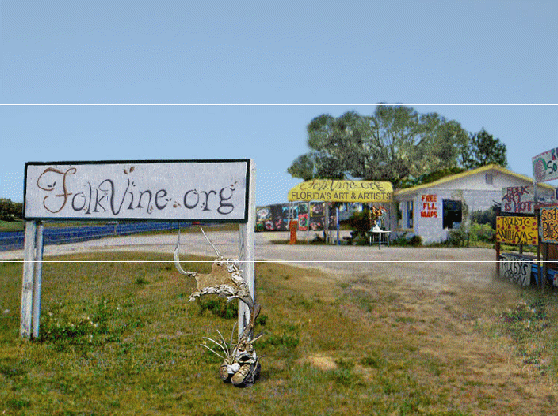
Obviously, a large-scale website requires collaboration and external funding. So, the website had to appeal to the Florida Humanities Council. Those publicly funded institutions' mandate, in their raison d'etre, that projects provide humanities content to a general-public usually in live events and forums. Following those demands, our project had premieres in which we gathered input from the public. We argued that the online venue increased access to the content, but the Council cared initially about getting the content to a public. Look around outside the tourist center, then, click on the news-stand to read about the events and other news surrounding the project. We did not stress the crucial issue discussed here and motivating our production: how to present the material in terms of electronic literacy and the mix of deep- and hyper-attention, issues that Hayles examines in terms of electronic fiction.
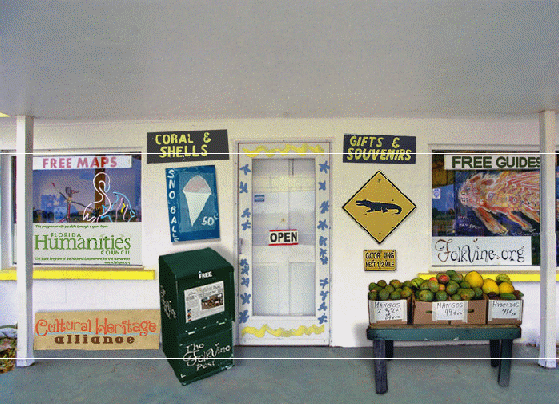
As you can piece together from the articles in the Folkvine Post newspaper, in a series of Saturday afternoon events, the Folkvine group invited the public to enjoy the sites and related cultural events. The community then gave feedback directly to the group, and on Council evaluation forms, on how to further refine the sites. The group had already met with our selected artists and their communities, researched their traditions, and constructed drafts of the websites. At each of these gatherings, the team introduced our website, and the artists, community members, and other interested participants shared their ideas about the site and the events. The team, then, compiled the suggestions and gathered important new information, interviews, and research. We would then complete the sites. We presented ourselves and the website as good citizens, rather than as advocates for a visceral scholarship or an alternative to academic print-culture ethnography.
Valuable as stand alone events (see for example the huge celebration including Hula demonstrations at the premiere of Ginger LaVoie's Folkvine site), these public gatherings became key to the development of the Folkvine project and the evaluative process. Food, dance, performances, music, and fun complemented the introduction of these sites to the public. Documentation of the events became parts of the websites. During the first year of Folkvine, the group staged three large celebrations where we premiered the sites and asked for community input (including artworks and projects produced by the visitors). The events served a traditionally African-American community in Bealsville, a central Florida Polynesian community, a community of former clowns and clown shoe-makers, and a community of miniature circus makers. In the second year, the events reached three distinct underserved audiences. The audience’s served included the following: a bilingual audience from a Puerto Rican community, some of those associated with the migrant workers communities in central Florida; a community of Space Coast residents and artists serving the tourist trade; and, an African-American community, including school age children, involved in an artist’s project to revitalize their neighborhood and their community. Many thousands have participated in the websites online, and in both the live events and the website, Folkvine fulfilled its mandate from the Council to provide public access to humanities content.
The Humanities Council's appropriate interest in humanities content corresponds directly to the effort to fix a text's meaning (i.e., its content) against the vicissitudes and contingencies of its transmissions and readings. As Richard Lanham famously explains in The Electronic Word, "establishing the fixed text has been the humanistic raison d'être since the Renaissance. To nail it down forever and then finally explain it, that has been what literary scholars do. All our tunes of glory vary this central theme, even our current endeavors to show once and for all why nobody can once and for all explain anything."11 As soon as we made our cultural text more accessible and available online we "volatilized" it, in Lanham's term, and thus followed in the trend in e-Media to abolish the fixed "edition" of the great work and so the authority of the great work itself. Such volatility questions the whole conception of textual authority built up since the Renaissance scholars resurrected Alexandrian textual editing.12 Although Lanham, in this citation, discusses the literary canon, the volatility applies equally to ethnographic research. As soon as we moved the research from page to screen, it became "unfixed and interactive," and for Lanham that not only challenges "the fixed, authoritative" text, but rather "explodes" it "into the ether."13 We had a delicate balance even within our own minds best represented in the backgrounds of the lead folklorist Kristin Congdon, from whose research and forthcoming book we initially based our project, and my own interest and research in media theory, experimental online scholarship, and networked art. The two prongs, almost contradictory, sought to both empower those portrayed by allowing their vision to strongly inform the design and to "volatize" scholarly design in ways fitting to e-media. The concern was to make the project about the folk artists rather than about "us" and our concerns.
Within these constraints, the team learned, over the two plus years of the project so far, that the two motivations actually reinforced each agenda. So, diplomatically challenging the effort to conserve a fixed set of cultural practices and heritage, reinforced and strengthened the empowerment of each artist. The folklorists, Professors Congdon and Underberg, already had an interest in examining shifting and re-creative identities [inside the tourist center click on the Re-creative Identity Tour Guide] as well as ambiguities in the boundaries between heritage, or folk traditions, and individuals' alternative world-making visions. The experimental design strengthened, and highlighted, issues like mood, sensibility, and atmosphere that more accurately convey the ambiguous relationship between a visionary artist and a cultural heritage. The lively volatility of the design, that sought to "channel" (in the term adopted by the lead web-designer of Folkvine.org, Chantale Fontaine) the vision and voice of the artists studied allowed for both empowering the observed and challenging fixed representation.
This essay describes an experiment in ethnography, and in scholarly online presentation. The argument of this essay touches on critical and Foucaldian approaches, applied community-based arts education, and aspects of traditional folklore, but the experiment is in its scholarly presentation. This presentation offers an alternative to an invisible and transparent style assumed to be the only appropriate style for scholarly presentation (online, as a lecture, or in print).
Following the general introduction to the (sometimes conflicting) motivations for the project, this essay now turns to the strategies and types of presentation, crucial background on how the individual parts were constructed, and, finally, a theoretical justification for the experiment.
The implicit argument of the experiment, that design is a crucial aspect of the message, and that the message is the sensibility of the artists and traditions explored, may not always succeed in the particular web-designs discussed. The argument does nevertheless have a claim as legitimate scholarship. It is not simply about art and design, but about a way to capture something that literate logocentric scholarship and ethnography has difficulty capturing. The visceral, visual, and sonic qualities, etc., and most importantly the sensibility of artists and traditions are the focus and goal of the experiment. But since the individuals involved and the funders were not completely sanguine with this approach, this essay also describes how to run an experiment within a conservative context of funding and scholarship.
The essay and website are not art experiments themselves, but present an explicit criticism of other scholars' discussions of website design, making the claim that this line of research is legitimate across disciplinary boundaries throughout the social sciences and humanities, and within scholarship on teaching and learning.
One could argue that this essay offers a model (admittedly imperfect and experimental) for an alternative form of scholarship. Many will find this unacceptable, because it allows the medium to function as an important part of the message. To others inside digital media studies or e-Media studies, it will be a modest demonstration of the crucial lessons that they routinely teach in their theory and history courses about e-Media studies. To those setting the protocols and standards for the presentation of research online in a particular discipline, this claim may await and depend upon more applied examples.
But our premise is that design can be a part of scholarship, not merely an ornament or a necessarily invisible lens for scholarship. e-Media has a special advantage in that everyone can utilize design work for a new type of scholarship. Some readers will never accept this claim as legitimate. This essay describes ways that we tried to speak across that divide: to appeal to those who distrust the concept of art and design of/as scholarship.
An online project has the advantage of many entrances and Folkvine includes a radio program, produced by the Council's own radio show, about the site's production. From the tourist's center's front desk click on the radio on the bottom shelf. The radio program loads and a window textbox identifies the program. All of the links from the tourist center suggest alternative entrances (figuratively and literally) to the sites, cites, and sights. This essay will return to these entrances, but for now listen to a bit of the radio program.

In an effort to conserve and document folk life, and as part of research in digital humanities, Folkvine.org seeks to translate scholarship into interactive multimedia online. We built an elastic and changing team including as many as five professors, a lead artist and web designer, a professional media maker, part-time staff, and graduate and undergraduate students. Not everyone in the world can visit a folk artist at home in rural Florida; so reflecting the surrounding communities, cultural heritage and the processes involved in making art and building communities guided the project's design. With the sincere effort to frame the project in terms of cultural conservation and heritage, we also began to volatize the way we read and interacted with the art and heritage.
The team made Folkvine.org with the artists' style as a guide to make the websites more accessible, and accurate, portrayals not just of objects and products, but also of processes and visions. The project also serves the communities surrounding the artists portrayed. It conserves and celebrates their local cultures and art; it shows how the artists’ works play a crucial role in those communities; and it serves as a way to allow those communities a venue and entrance, via Folkvine.org, to an international audience for their cultural arts heritage. Many thousands have participated in the websites online at Folkvine.org and we began to realize that although the world could not beat a path to these artists, we could open a window on to their worlds. Some of these artists have gone on to prominent careers selling art and others never had any intention to sell their works. So, it becomes doubly difficult to allow outsiders to see, hear, and experience these communities and artists outside the art markets and economies of success.
Ruby Williams sells her increasingly valuable paintings and her own farm-grown vegetables from a road side produce stand located in a rural African American community in Bealsville, Florida. She has had an exhibit at a branch of the Smithsonian and has won numerous State and National honors and awards. Note the entrance to Williams’ site via a vegetable stand (rather than through the typical flat design of scholarly presentations). The stand is not symmetrical, and it is a composite image of her paintings on boards included with her vegetable stand. Does that composite form of presentation count as scholarship? Is it more about the Folkvine team and our interests? Or, does it illuminate something usually effaced by supposedly accurate documentary forms? Before turning in greater depth to those questions, here are the artists, and their works, that the site documents.
The Scott family (Wayne and Marty, and their apprentice-son Alan), who used to tour as a family of clowns and circus workers, now pass down the tradition of hand-made custom circus clown shoes in their rural home workshop. The site's design reflects the DIY's (or bricoleur's) hobbling together, that you find in every aspect of the Scott family's life. Listen to the sounds of laughter and clown's mockery on their splash page.
Ginger LaVoie makes Hawaiian quilts and, although non-Polynesian by birth, became culturally Polynesian when she spent almost three decades learning traditional quilt making from Hawaiian elders. She now serves as a vital link with the local Hawaiian community working to ensure the continuation of the tradition. Listen, on LaVoie’s site's introduction, to the stories about smoothing and caressing quilts as a crucial part of the Hawaiian quilting tradition. The design of the introductory video and the splash page reflect her sensibility and the aesthetic design of the quilts. So, the quilt on the splash page is a composite quilt built from miniature images of LaVoie's quilts.
Former circus clown Diamond Jim Parker made miniature model circuses and had an important archive of clown, sideshow, and freak show history, paraphernalia, and photographic records. Sadly, Diamond Jim passed away during the work on this project. Museums and private collectors divided up his circuses and archives. In his interview, he specifically asked me and the Folkvine team to portray his circus-y sensibility. He was particularly concerned that we not decontextualize his life and work for hanging on four white walls of a museum's gallery. We happily agreed to avoid the dry museum-like biography or exhibit that typically sacrifices sensibility and atmosphere in favor of the legitimized authority of the fixed and decontextualized findings. Look at Diamond Jim’s site and how the design uses the look of artisanal crafts associated with old time circuses. Roll over the miniature circus and listen to the sounds of circus life.
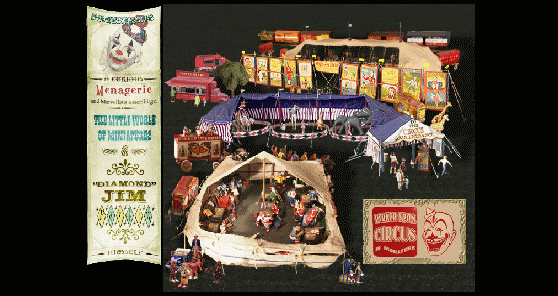
Taft Richardson, an African American artist and preacher from Tampa who constructs fantastic sculptures from discarded bones, has started a community outreach program for children who work on art projects, especially masks, at his house (now named Moses House). He builds sculptures of animals, birds, insects, reptiles, religious icons, and people out of the discarded bones of animals that he finds. The finely crafted bone sculptures have small figures hidden in the patterns of the larger animal or human figures. Listen to Richardson’s discussions of his allegorical connections to his bone sculptures and how that informs his community activism and art education.
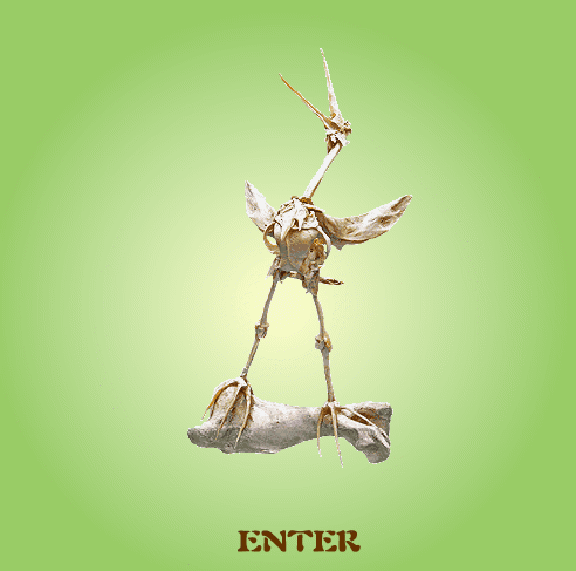
Notice how the site's splash page, shown and hot-linked below, highlights the Edenic green oasis Richardson created (literally and figuratively) in the grey industrial wasteland that used to be the center of a thriving African American community (before a huge road cut the neighborhood apart).
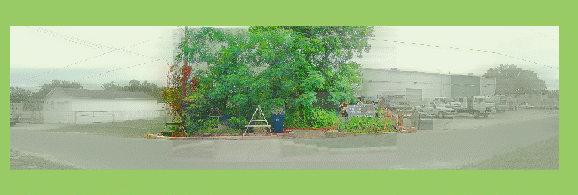
The Richardson splash page obviously creates an allegorical mood by processing the colors and photographic images rather than present a supposedly accurate window on a fixed documentation of Richardson's house and neighborhood. Instead, the project seeks an accuracy more in keeping with online scholarship's ability to capture sensibility and allegorical connotations.
Navigate through all these sites and recognize how the design functions not as mere ornamentation for humanities content, but as the visceral meanings and entrances to the sensibilities of these artists and their communities. In this sense, Folkvine portrays the artists and their communities in a way that they would choose to represent themselves if they were web designers. Instead of a sterile neutral design, the project sought to design sites that reflected the aesthetics and sensibilities of the artists in both form and content.
The website demonstrates precisely how e-Media forms and approaches change the content presented. It change the types of content available by including visual, aural, and interactive materials. It also changes the essence of the materials; it makes the reading experience more visceral by presenting a different kind of information (mood, atmosphere, sensibility, etc) that print-based nonfiction scholarship has had difficulty presenting. These effects are explicitly demonstrated, but less important for the various reviewers and administrators who care (correctly) about providing the general public with humanities content. The very enthusiastic agencies tended to describe specific design strategies as ornamentation to the content. In our explanations, the theoretically guided strategies, that produced a scholarship that accounts for mood and atmosphere, for example, were reduced down in the eyes of external reviewers to the adjectives fun, entertaining, inspiring, and educational. This author, and the Folkvine team, happily uses these terms and appreciates their value. For the purposes of this essay, the actual motivations and demonstration, in the website, are much more precise and nuanced.
We examine these issues in other publications, but the questions particularly relevant for e-Media studies focus on how detailed and specific e-Media design decisions produced, and highlighted, unique types of meanings usually unavailable in print-based or visual anthropology. Although there is an extensive theoretical foundation, we could find no examples of experimental ethnography online. Much of the experimentation in e-Media exists in hypertext fiction, games, digital art, installations, and video art. It is much more difficult to find extended serious scholarship that takes advantage of the possibilities and advantages of e-Media. What are those available unique strategies?
Note the splash page of folvine.org, portraying a composite of artifacts from the Folkvine research, an actual old tourist center, and clichés of old-time Florida tourism, in the Florida Cultural Tourist Center, from which you can access the sites via choosing postcards that open on to the individual sites. Does simulating mood and atmosphere inherently prevent the site from serving as scholarship?
On the counter of the Tourist center sit Tour Guides. Click on one and it opens a book, impeccably designed to look just like a tour guide. Except instead of describing where to eat or what hotels to consider, it discusses humanities topics directly related to all of the sites and artists. One tour guide, for example, is titled Re-Creative Identity, and includes topics like recycling objects and recreating identity and communities. Within those topics the guide discusses the Scott’s prop-shop, Lilly’s Vejigante masks, Kurt’s universe of animals, Ruby’s walk-in gallery, Diamond Jim’s kit-bashing, and much more, all in the style of a tour guide complete with icons and links to humorously presented commentary (when bobble-head figurines pop-up portraying the caricatured look of the humanities scholars on the team). Close the tour guide and return to the front counter. Make sure to roll-over anything of interest the way a tourist might handle trinkets and guides.
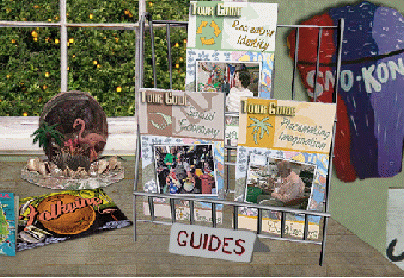
The bobble-heads discuss serious humanities topics and historical contexts related to sections of the tour guides. The bobble-heads make the site "fun" for those interested in content only, but the Folkvine team chose bobble-heads (and created conventions for the bobble-heads) that would poke fun at the self-important seriousness of scholarly commentary (even as we continued to produce it). In that way, we sought to use a Brechtian device to encourage a critical laughter and delight.14 Just as fictional forms of e-Media appeal to different levels of interpretation, the bobble-heads function literally as ornaments for serious humanities content (we have bobble-head voices, but also scrolling text with a scholarly citation system) as well as interruptions to the usual transparent style of scholarship (online). Click on a bobble-head in the tourist center, and they appeal to you to choose their interpretations, spell their name, and encourage you to learn more about their scholarship. In that way, the scholars, and their scholarship, become characters in our portrayals rather than invisible observers. In one of the public events, this author, and the entire audience, put on clown noses. Again, it could be interpreted as fun ornamentation to the serious conservation of cultural practices; the decision to have everyone, scholars and audience, wear clown noses also speaks to James Clifford's concern to avoid placing the subject's of anthropology and ethnography in a "relationship of dominance."15 Brecht succinctly explains the difference of his theater from Aristotle's dramatic theater.
"The dramatic theatre's spectator says: Yes, I have felt like that too – Just like me – It's only natural – It'll never change – The sufferings of this man appall me, because they are inescapable.... The epic theatre's spectator says: I'd never have thought it – That's not the way – That's extraordinary, hardly believable ..."16

Visual anthropologists find in Brecht's work, a fitting analogy. Peter Biella turns to Brecht to examine a problem for ethnographic media makers. "Intimate footage – whether in news, documentary or ethnographic film .... If viewers are often stirred by images, they are rarely stirred to action."17 Biella suggests that just as "an actively self-critical theater serves as a model for self-critical, reflexive political analysis and activism in the real world," ethnography might turn to a self-reflexive model. In a similar Brechtian critique, that Biella also cites, Jill Godmilow argues that an emotional response to "traditional [Aristotelian] documentaries" replaces the impulse for action. Such films encourage audiences to
feel that they’re interested in other classes, other peoples’ tragedies, other countries’ crises. By producing their subjects as heroic and allowing us to be glad for their victories, or producing them as tragic and allowing us to weep, [traditional documentaries allow the audience to experience] itself as not implicated, exempt from the responsibility either to act or even to consider the structures of their own situation .... [Movie audiences] feel they’re somehow part of the solution, because they’ve watched and cared.18
"The task," for Godmilow, is to volatize viewers’ "coherence, manageability and moral order" to challenge viewers' frames and worldviews with insights that, according to Biella, "make action a logical and emotional necessity."
The bobble-head commentary, like the use of the artists' style as a design guide, also demonstrates an alternative Brechtian ethnography advocated by Biella, Godmilow, Clifford. The use of honky-tonk knickknacks, a campy icon of low-brow popular culture, to express insights about folk artists involved specifically in bricolage argues, by demonstration, that one can learn most about these cultural practices through interactive participation. That the participation involves (Brechtian) fun suggests a way to evolve the scholarly protocols toward accepting design as a legitimate form of critical scholarship. Clifford describes how anthropology and art history participate in a movement from recognizing an object or practice as inauthentic, common, and ephemeral junk to rare artifact always appear in "zones of contest and transgression . . . as movements or ambiguities among fixed poles."19 A goal of the Folkvine project, to change the way we think about art and about how we consider presenting the stories of artists' lives and work, meant designing a scholarship appropriate to ambiguities among fixed poles. Instead of fixed artifacts, traditions, cultural practices, and even scholarly protocols, the project demonstrates diplomatically, and with fun, a scholarship of contest and transgression. The design of the websites to look, feel, and sound like an analogy for each artist, their life story and the story of their work and community presents a model for online scholarship, ethnographic internet design, and a way to talk about both the portrayed and the culture of representation.
Luc Pauwels correctly notes that using visual images portrays not just "what is depicted," but also "how it is depicted." But, he sees this as a problem because the visuals portray "the culture of representation as much as ... the represented culture."20 Just as Birkerts had earlier condemned non-print-based e-Media, because it supposedly replaced logic and conceptual thinking with imagistic impressionism, Pauwels, in particular, but also those who support some use of e-Media for ethnography, condemn, or at least worry, about visual information online.21 The adoption of e-Media must support, for these scholars, scientific goals by rejecting a style "incompatible" with the situations, objects, and peoples portrayed. That style includes "flashy editing, unusual camera angles and movements." These effects often trick viewers into considering the quality of the presentation as a "sign of 'professionalism' or creativity rather than a flaw."22 These supposedly "new and attractive features and devices may seem to brighten up the presentation and discussion of facts and views," but, in fact, they may "seriously jeopardize," for Pauwels, "the (scientific) usability of the product."23 He does leave open a possibility that "thoughtful combination" of "visual and auditory channels" "with great skill and consideration" "may lead to very compelling forms of scholarly communication."24 In Pauwels terms, we produced an "expressive" design to comment on "the recorded subject matter" by "keeping some distance or 'deviating' from reality."25 but we used this strategy to go beyond the scientific goals of traditional documentation and conservation. We also adopted the "expressive" research strategy to portray sensibility, mood, atmosphere, and aesthetic appreciation of those portrayed. After nearly three years since we began talking about the possibility of the project, the website demonstrated the possibility of combining documentation of facts and products with expression of processes and personality. e-Media's "flaws" can serve as elements in an expressive design, as an analytical tool, to appreciate something missed in print-based media. Whether or not we succeeded in reaching that goal remains open until others replicate our findings and begin to produce a cultural science (a social science of cultural sensibility) in e-Media.
The objective voice in print, describes the scene, sounds, practices, and conventions. That third-person narrator overlays conceptual categories, like social economy or place-making imagination, on to the observations. Folkvine.org not only sought to change the relationship between observed and observer, but also had the opportunity to literally include the folk artists' voices and works. Now, observers and observed, as well as descriptive speech and media design, all played roles in a contested play on how one performs scholarship online. As Ruby Williams paints on one of her paintings, like anyone of her many painted sayings, that often are barbs to the viewer, the project literally points to "school this way" (with a character in the painting pointing at the phrase and the school). Using a scholarship of objects and interactivity will paradoxically increase both Brechtian critical distance, or alienation, and intimacy with the visceral experiences of the artists. A scholarship of objects and interactivity demonstrates that e-Media can make ethnographic portrayals more accurate and engagement more intense.
To change the way we go to school (i.e., scholarship), the processes can change to include folk art as a model to school this way: to add a narrative path, to tell an interactive story, to tell the story through engagement with tactile objects and visceral experiences, and to simulate the peculiar sensibility of the artists and their communities. You learn about folk art by virtually trying out the practices and pleasures. We borrowed these artists’ sensibility as a model to use new media, not to romanticize their work, lives, or communities, nor to elevate our work as recovering a supposedly purer world. The project's strategy used e-Media to get at someone’s sensibility – not just the facts – not ignoring the facts – but presenting the facts as an analogy for the experience one might encounter with these artists. Analogy functions as a foundation of understanding in the humanities rather than the standard of falsifiability used in the sciences.
To describe, and demonstrate, this process we borrowed a term from Diamond Jim Parker's explanation of his specific way of working. In making his miniature circuses, Parker discusses the three methods used by model builders. Kit-Detailing follows the plans in a model kit, but adds hardware or other embellishments to the model. So, Parker might take a model train, and glue on a Barnum and Bailey label to make the train a circus train. Scratch-Building involves creating models from scratch using raw materials like balsa wood without using a store-bought kit or plans. Kit-Bashing involves using a kit, but breaking, or modifying the models, to make each figure fit with the specific needs of the builder. Parker would break, and re-glue a figure to transform a train worker into a circus worker.
Kit-Bashing became a way to guide the design and presentation of the stories on-line. The project kit-bashes scholarship as well as folklore; it depends on both as a foundation. Folkvine does not reject those scholarly protocols, but it uses those methods and paradigms, or designs, as occasions to experiment – to get at something beyond the documentation, the presentation of evidence, or the theoretical speculations.
By using the Internet, folklore and scholarship could be available to a larger audience and encourage these artists communities to expand beyond their geographic boundaries, but distributing the works of art changed the art from something anchored, and fixed, to a particular time and place, to something that literally meets the user half-way. The object of study becomes a paradigm of scholarly design. Just as conceptual artists have turned again to folk art as a model for their own work, for example Margaret Kilgallen’s installations like To Friend and Foe (1999) that appropriates carnival signage, the Folkvine project uses the works studied not simply as objects to analyze or promote.
As models, or analogies, for scholarly methods, these appealing approaches to arts and crafts makes scholarship accessible, makes us think of scholarship as an arts and crafts – a practice, an art like folk art focused on its meaning for a community of participants. In terms of this model, the Folkvine project also allows for, what the second folklorist on the project, Natalie Underberg, calls a reciprocal relationship with the cultural works. The way the works and artists told stories now became a model for how we could tell the story: not to romanticize these communities in a version of Primitivism,26 but to strategically use some of their methods to get at something usually difficult or impossible to experience in print or in descriptions. Sensibility – a sense of humor, for example, or the fascination with the circus-y – these usually resist collections of facts or the best intentioned theories of folk communities and their arts.
Instead of connections to abstract categories, and received ideas, like tradition and community, the websites convey the message visually, aurally, and in narrative form – you take a walk through an artist’s world and discover insights in a narrative, and often allegorical, walk through, rather than as an argument alone. Previously, scholars often reduced stories and folk art down to mere symptoms of the structures of communities and traditions. Folkvine sought to use the folk art style of storytelling rather than impose a social scientific model. As you move through the site yourself at Folkvine.org you’ll see the struggle to make the sites express narrative solutions rather than neutral arguments about community, religion, and other abstract concepts.
The kit-bashing model changes the relationship between observers and observed. It also changes the function of the folk art: no longer examples of an innocent past, but models of a potential future and ways to tell stories. Ethnography on the web allows for a more experiential record than a printed or photographic portrayal. In looking over the Folkvine sites, notice how sounds, interactive games, color, and (mediated) tactility seek to create an experiential, rather than merely descriptive, portrayal of an artists’ sensibility. Paul Stoller’s provocatively titled The Taste of Ethnographic Things describes how the Songhay people consider "taste, smell and hearing" as "more important" than "sight, the privileged sense of the west. ... one can taste kinship, smell witches, and hear ancestors."27 Of course, these experiences exist in our homes as well (even in the West). Sarah Pink, in her Home Truths, begins her book by citing Stoller and then explains that although modern western discourse might not privilege the other senses, we use those senses everyday to create our sense of home life: "one might feel dirt, smell the landlord’s neglect, and hear the sounds of being at home."28
Spend time on Ginger LaVoie’s site, where the Folkvine team used the roll-over motion as a tactile analogy for caressing fabric or removing quilts from a stack one after the other. Listen to the laughs and other circus sounds on Diamond Jim’s and the Scott’s site. Make your own painting, artworks, or poems on Lilly or Kurt’s sites, or make your own shoes, to get a sense of the experience of combining stuff to make art. On Lilly's site, look around the studio and choose "make a vejigante mask" and then in the new window choose "make your own vejigante mask." Toward the bottom of the page in a section of Kurt's site, choose "make your own animal," then enter variables in the form to create your own poem and painting in the style of Zimmerman. On the Scott's site, you can design your own clown shoe by choosing create-a-shoe. A favorite interactive segment, especially among children and academic scholars alike, involves creating your own clown names. It is surprisingly fascinating, and we have watched visitors at public events enter name after name to see the equivalent clown name generated by the Clown Name Apparatus machine. Enter your name or the name of some clown you know to see various clown names.
You might forget, especially in the midst of a printed description filled with abstract categories, that sensual experience creates and reinforces the social economies of these artists’ homes and communities. The sense of home and place is about a certain smell, sound, touch, or taste as much as about what realtor’s call curb appeal: the look of a house. Folkvine focuses on the handling of fabric, sewing leather with a deafeningly loud machine, or painting on a board with house paints in a hot sunny field with the smell of ham hocks and greens mixing with the paint fumes. It asks the visitor to consider the dirt of a garden under the painter’s nails or the many other sensual qualities we can only experience rather than read about how those experiences are symptomatic of socio-economic, gender, or racial situations.
The artists portrayed on Folkvine.org all stress the tactile and sensual aspects of their works especially as these create relationships and social economies. Taft Richardson speaks about feeling the presence of the woman who used to live in his house; he describes how he lost friends who could not understand why he was picking up bones; and, he might let you touch the remnants of other people’s hair weaved into his own beard. His goal is to heal his community which was literally torn asunder by a six-lane road through the middle of the neighborhood and is figuratively trying to pull itself together in the face of dire poverty, crime, and a lack of external support.
This cultural pattern and atmosphere of connectedness to heal a community resembles a child's effort to mature. A child has a transitional object, a "blanky," a "binky," a dolly, or just a thumb-in-the-mouth, that allows the child to slowly separate herself from her mother. To mature she must conserve and protect her sensual connectedness to people and the world. At the same time, she must find her own voice and feel her own path through the world. Sometimes adult communities need to heal in a similar fashion, and some of the artworks on Folkvine.org have remarkably sensual and intimate qualities much like a child’s blanky. They embody a practice that seeks to encourage a renewed communal connectedness and a more direct engagement with the world around us.

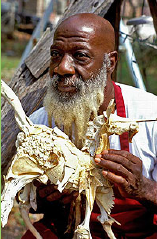 Starting
in the early 1930s, Melanie Klein theorized the way children's
maturation involved specific relationships with their objects (toys,
baby quilts, small objects, etc.). These relations have ambiguous
motivations; and, in terms of the folk artists, the motivation was
similarly complex. They sought to both find a connection to a community
and its heritage, and, at the same time, reconfigure (or kit-bash)
those traditions according to their own vision. The transitional
object, to suck on, allows the child to play out suckling and its
weaning. For Klein objects have a rich symbolic life in our
associations and creative life.
Starting
in the early 1930s, Melanie Klein theorized the way children's
maturation involved specific relationships with their objects (toys,
baby quilts, small objects, etc.). These relations have ambiguous
motivations; and, in terms of the folk artists, the motivation was
similarly complex. They sought to both find a connection to a community
and its heritage, and, at the same time, reconfigure (or kit-bash)
those traditions according to their own vision. The transitional
object, to suck on, allows the child to play out suckling and its
weaning. For Klein objects have a rich symbolic life in our
associations and creative life.
The use of objects to heal and conserve communities, and their threatened heritages, has an analogy in Klein's non-verbal play technique. In her therapeutic practice, that has grown into object relations analysis, an analyst gives the child a small toy and observes the symbolic meanings of the play. To protect the child's intense personal involvement, the therapist showed the child the separate box for storing each child's toy between sessions. In an expansion of Klein's work, D. W. Winnicott explains how these transitional phenomena "spread out over the whole immediate territory between inner psychic reality and the external world as perceived by two persons in common," that is to say, over the whole cultural field that includes not just child's play, but artistic creativity and appreciation.29
Thus, the Folkvine project sought to find an e-Media design appropriate to the artists' intense relations with objects as an expression of a relation to a community and heritage. To create a design that illuminated the expressive and visceral importance of these objects meant video and photography, according to Lynn Tomlinson (the project's lead artistic director, editor, and videographer), that would have sensitivity to the artists' relations to their particular objects (e.g., clown shoes, bones, quilts, a treasured vegetable stand, etc.). To smooth and caress a quilt connects Ginger to a long tradition of Hawaiian arts as well as to her physical, sensual connections to the world around us. Her quilts, charged with an energy far exceeding their explicit decorative function (they are not used as blankets), help the user to mend and stitch together both the pattern of where she fits in the social economy and the comforting suckle that only that pattern of connections reinforces. Click on the sharing culture video on the right side of the page. As the site volatizes the typical neutral and transparent style of scholarship and mimics the so-called outsider artists, the Folkvine project opens itself to claims that it lacks seriousness. One might claim that the site is clowning around rather than presenting serious, and significant, scholarship. Two overlapping groups of artists represented on Folkvine.org, the late Diamond Jim Parker’s community and the Marty and Wayne Scott family’s community, have obvious and explicit connections to clowns and clowning. As you can discover from the biographies on the individual sites, both Diamond Jim and members of the Scott family worked as clowns, and their works directly relate to the circus. The Scotts continue to sell their hand-made clown shoes to circus clowns and they continue to perform prop-clown acts for their Christian Clowning community. Diamond Jim’s collection of clown paintings, photographs, and circus ephemera (as well as his hand-made miniature circuses and fairs) continued his passionate and nostalgic connection to the clown’s life.
Other
artists on Folkvine.org have deeply comic aspects to their work. Ruby
C. Williams often uses caricatured figures and humorous captions. Her
painting style, lacking visual perspective and resembling
expressionistic cartoons, also adds to the delight and attraction of
her deeply comic work. Kurt Zimmermann’s expressionistic
paintings of
fanciful figures, like Chog, that combine parts of
two animals for
comic effect, and his parallel universe scenes, also belong in this
comic tradition. Although the Folkvine sites already include detailed
histories of clowning, the social economy of clowns places it in a
wider tradition of comic art. This
comic tradition includes artists like Alexander Calder, Red Grooms,
Saul Steinberg, Roz Chast, Pablo Picasso, and Jean Dubaffet. Art
historians tend not to group the artists on the Folkvine.org site with
these more prominent figures, nor even group these artworld figures
together. As this example demonstrates, the Folkvine project seeks to
re-situate art-making as a continuum according to issues and processes,
like social economies, rather than artworld or folk art pedigrees. To
find the commonalities and shared values rather than the market values
of artworks hopes to make art-making more accessible. Artists often
make art, not only for art’s sake or monetary economy, but
also for
joining in a social economy and community. Comic
art spans the limits of geography and time. Arthur Danto, art critic
and theorist, connects clowns and comic art to the lowest comedy of
Bushmen laughing in delight at a sacrificed antelope in its final
spasmodic death throes. Lowering one’s self, allowing others
to laugh
at your pathetic costume, like absurdly bulbous oversized shoes, or
slapstick misfortune, allows the audience to feel both better about
their own situation and less intimated by the travails of the world.
Your shoes might not fit, and you may appear in public looking silly,
but not as silly as the clown.
Danto, in an essay on Red Grooms,
explains that the clown takes on the appearance of "inferiority" in
order to make the audience "feel better about themselves,
their lives,
their world."30 The deep comedy of the
artists
mentioned above not only
brings the high low, it also reconciles differences; no longer
intimidating, or something to cow-tow to, the world and other people
are just like us, neither threatening nor outsiders.
In
this sense, clowns and clowning, both forms of comic arts, have a
socially conservative function in society. Clowns play the role of
goofy, silly, and lowly characters in order to "sacrifice" themselves
for the "moral welfare" of the audience. They do
this in performance
after performance.31 Different than deeply comic
art, the clown’s
performance does not ask the audience to "see the world in a
new light.
The action runs in only one direction, a lowering of the clown and a
compensating elevation of the audience, without a compensating
countermove in which the ones raised are returned to a world seen as
itself redeemed."32 The easy laugh,
that
requires no change in the
audience’s world-view, makes some see the classic clown acts
as cruel.
After all, clowns make cruel jokes about their physical state. Diamond
Jim’s act often involved shooting a midget out of a cannon.
Even the
clown’s cartoon-y mock-stuff makes us laugh at the clown. The
Scott’s
prop-act often involved puns, mocking large objects like a hair comb
the size of an arm, and the absurdity of finding an object in an
inappropriate place like pulling out a handkerchief that eventually
pulls off and out the clown’s boxer shorts.
Even
in real life clowns’ social standing was often low down in
the actual
working conditions and wages in circuses. Diamond Jim recounts how
previous circus worker hierarchies put clowns at the bottom just above
the animals with trapeze and other high wire acts literally and
figuratively higher up the ladder. Ordinances in some towns, where
circuses parked in the winters, forced both clowns and animals to move
to towns like Gibsonton, Florida. Gibsonton became famous as a
welcoming home for clowns and freaks. Some
of the clowns artworks included in Folkvine rise above clowning to
become deeply comic, as Danto explains, by changing our world-view and
redeeming the world around us. Ruby, Diamond Jim, and the Scotts all
explicitly discuss their intention to make art as a healing redemption
for the world. Return to Diamond Jim’s site on Folkvine.org
and look
carefully at the miniature circus world or listen to his descriptions
of his house. He intends to create a world, a "circus-y" world,
populated with freak shows (look at the hand-painted banners in his
circus), clown acts (peek inside the tents), side-shows (look around
the alley’s of the circus), and scandalous voyeurism (we can
see
illicit acts on rooftops and inside the windows of the model world). We
leave less threatened by the seediest side and lowest form of the lost
world of the circus train and life. He unwittingly left us a legacy
beyond his nostalgia for the cruel world of clowns. For example, he
bemoaned animal rights activists protesting and ultimately eliminating
acts like his that involved supposedly humiliating animals as well as
midgets; his act done in drag with giant clown-shoe feet once famously
made fun of the Japanese practice of foot binding at a performance for
the Japanese princess. His miniature circuses become a deeply comic
art, like Red Groom’s installations, that redeems our quirky
odd world,
including the seedy migrant life of freaks, clowns, and side-show
hawkers. Before Diamond Jim died he urged us to recognize and redeem
the circus-y, including the unseemly side, usually not allowed in
correct serious society. In his miniatures, he creates unseemly scenes
of voyeurism that capture the seedy pleasures of that comic world. Lynn
Tomlinson's photographs, of these miniature scenes, reproduce the
surprise of noticing what is in plain sight. Somehow, in the context of
a house packed with a miniature circus train, one notices the scene
slowly, and with the surprise of a double take. One leans-in and
squints. Leaning-in is the phrase that Steven Johnson uses to describe
the zeitgeist of e-media culture versus the leaning back of the
reflective print-based culture.33
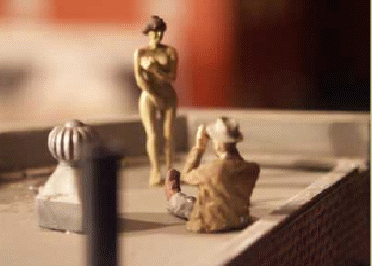 |
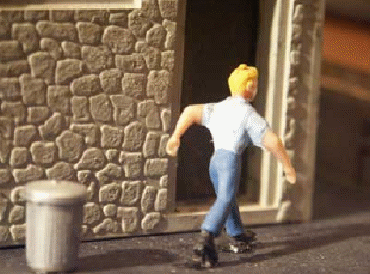 |
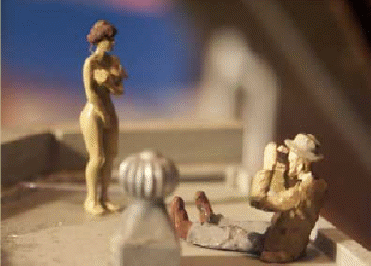 |
Because
hypermedia websites have no page numbers to create linear bearings,
navigation depends on the visitor creating a mental map of the
ethnographic space (and, as Bruce
Janz, the Folkvine scholar involved
in studying the place-making imagination, would describe, as spaces
becoming places) and constantly looping back in what we might call
double takes or leaning-in. This type of navigation does not create a
single path, but instead explores a space. In that story world, enigmas
and plots remain, but there is not a single answer or definitive
closure. The same is true of the miniature circus with many contiguous
scenes of intrigue. Who is the blond haired character about to enter
the building? What precisely are the two characters on the roof doing?
Is it a pornographic photo-shoot? Is the photographer duplicitous? How
does the scene relate to the surrounding scene of a circus setting up
in town? Is the circus connected to this voyeurism and pornography, or
a happier alternative (i.e., both the literal circus in this particular
model world and figuratively in general)? The miniature world has
frozen the scenes forever waiting for potential closure that will never
arrive just as the blond haired character will never enter the
building. Without one path toward an unfolding story, the fictional
space consists of world building, like the miniature circus world,
rather than a traditional unfolding story.34
Mark
Bernstein’s and Erin Sweeney’s The Election of 1912 – interactive
narrative nonfiction and one of the first hypertexts produced
– uses
context and contiguity to change how one interprets the bits of
information presented. In that situation, depending on the
reader’s
sequencing choices, the database seems much larger than a normal book
on the same subject.35 The perceived extent of
the database, and
corresponding choices available, can exceed the actual choices in
hypermedia. A bricoleur, a key term in anthropology since
Levi-Strauss introduced it
to describe a cultural practice, describes a tinkerer (a
"do-it-yourselfer") who
creates by organizing things and idea
in ways
not necessarily intended.36 It is a term that
narratologists use to
describe interactive hypertext fiction as well as the term used to
describe the precise techniques of the artists involved in Folkvine.
Interactive hypertext creates the circumstances for a new kind of
narrative unity,37 one created by reader
involved in a "rhapsodic
stitching together."38 The
visitor-navigator-as-bricoleur functions
much like the kit-basher, quilter, or DIY artisans, as bricoleurs,
who
appreciate their cultural circumstances in their working with their
objects – leaning-in and interacting. Visit the Scotts'
property and
you'll see the epitome of bricoleurs –
they've even built an
RV from
scratch with scraps they've collected in their giant storage barn. The
home-made RV vehicle has a bedroom/bathroom door, much like one
designed by Marcel Duchamp, that opens one room when it closes the
other.
Hypertext
scholars have examined how interactive fiction focuses less on the
subjective feelings of a character and more on the reading experience
itself. In a similar way, Folkvine uses the people and practices
portrayed as models for the presentation and reading (or more
accurately navigation) experience. 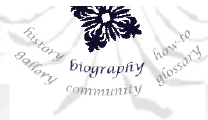 Because the
processes of navigation,
and design, become subjects in interactive fiction, these processes
replace writing (and readings) as finished products.39 The interactive
website demands intervention and interaction, and those demands create
an intimacy between reader and text.40 In that
scenario, interactive
fiction may give away the clear window into the soul of characters, but
it gains intimate access to the process of constructing meanings,
images, and narratives. It allows for a more accurate, if less
categorized, representation. By demonstrating similar insights in
Folkvine's nonfiction, the web designer of the navigation on Ginger
LaVoie's site, for example, chose patterns
and interactions that made
the visitor experience an analogy for the appliqué
quilt-making
processes. Notice also the patterned navigation site within LaVoie's
site.
Because the
processes of navigation,
and design, become subjects in interactive fiction, these processes
replace writing (and readings) as finished products.39 The interactive
website demands intervention and interaction, and those demands create
an intimacy between reader and text.40 In that
scenario, interactive
fiction may give away the clear window into the soul of characters, but
it gains intimate access to the process of constructing meanings,
images, and narratives. It allows for a more accurate, if less
categorized, representation. By demonstrating similar insights in
Folkvine's nonfiction, the web designer of the navigation on Ginger
LaVoie's site, for example, chose patterns
and interactions that made
the visitor experience an analogy for the appliqué
quilt-making
processes. Notice also the patterned navigation site within LaVoie's
site.
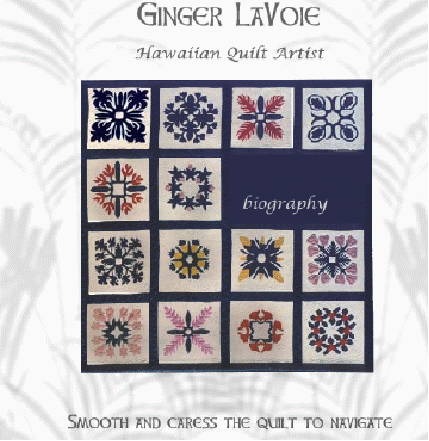
Just as literacy depends on print media, electronic literacy (or electracy) exploits features of the new apparatus: hypermedia is particularly good at expressing atmosphere, mood, and feeling all in the manner of folk art. An image, a figure (e.g., the experience of the folk artist bricoleur), can take on an "allegorical effect" versus the reality effect.41 In e-Media, the critical thinking of serious scholarship proceeds by the reader’s inferences about the connections among the pieces of research, art, and design rather than by following one grand narrative theory. Electracy teaches how to read the combination of texts, pictures, sounds, and design as meaningful not merely as ornamentation.42 Small bits eventually create patterns (accretion) or circumstances that create literary and aesthetic images even when used for critical scholarly purposes. Folkvine.org demonstrates that possibility even as it satisfies the need to conserve cultural traditions, clearly present humanities content, and make folk life accessible to a wider audience. It demonstrates that sociopoetic 43 experimentation and delivery of scholarly content, and conservation, are not mutually exclusive.
About the Author
Craig Saper, Professor of English in the Texts and Technology Doctoral Program at the University of Central Florida, is the director of the National Folkvine Project and the Co-Founder/Director of the Florida Folkvine Project. Visit Folkvine and a related community arts project at Community Mosaic -- email csaper at mail dot ucf dot edu for more information about current e-Media projects.
Endnotes
1 Thanks to three conscientious graduate students who helped prepare this essay for publication. Jonathan Glover copy-edited and formatted endnotes. Jennifer Turner formatted the bibliographic references. Kristin Powers helped track down references in visual anthropology.
2 Jensen, "Intermediation and its Malcontents," 543-56.
3 Hayles, Electronic Literature: New Horizons for the Literary. This is essential reading for literary studies.
4 See Pink (2001), (2003a), (2003b); Biella (1993).
5 Drucker with Nowviskie, "Speculative Computing," 431.
6 Pink, Doing Visual Ethnography, 156.
7 See for example Pink., 160-64.
8 See Birkerts (1994); Pauwels (2002); Banks (1994).
9 See Johnson (1997); Englebart; Kirschenbaum; Norman; Laurel; Hayles; Fuller; Bolter (1991/2004); Gromala; Manovich.
10 For an exception in film see Takaragawa; in online scholarship see HyperRhiz, eastgate.com's nontiction hypertexts, and especially Roderick Coover's Cultures in Webs.
11 Lanhman, The Electronic Word, 7.
12 Lanhman, The Electronic Word, xi.
13 Lanhman, The Electronic Word, 31.
14 Benjamin, Understanding Brecht (1973).
15 Clifford, The Predicament of Culture, 23.
16 Brecht, Brecht on Theatre, 71.
17 Biella referencing Brecht (1964), 189.
18 Godmilow, How Real is the Reality in Documentary Film? (1997).
19 Clifford, The Predicament of Culture, 226; cf. Saper, Artificial Mythologies, 33-37.
20 Pauwels, "The Video- and Multimedia-Article," 150.
21 Birkerts (1994); Pauwels 158; Pink 172; Banks (1994).
22 Pauwels, "The Video- and Multimedia-Article," 152.
23 Ibid., 158.
24 Ibid., 151.
25 Ibid.
26 Torgovnick, Gone Primitive (1990).
27 Stoller, The Taste of Ethnographic Things, 5.
28 Pink, Home Truths, 9.
29 Winnicott, Playing and Reality, 5.
30 Danto, 60.
31 Ibid., 62.
32 Ibid.
33 See Johnson, Everything Bad is Good for You (2005).
34 See Gaggi, "Hypertextual Narratives,"122-39.
35 Douglas, "Sorry We Ran Out of Space—So it’s Just a Guy Thing," 205-15.
36 See Strauss, The Savage Mind (1966).
37 Landow, "Reconfiguring Narrative," 181-207.
38 Sloane, "Problems with Hypertext Fictions" (2000).
39 Niesz and Holland, "Interactive Fiction," 110-29.
40 Ryan, "Immersion vs. Interactivity: Virtual Reality and Literary Theory" (1994).
41 see also Ulmer, "A Response to Twelve Blue by Michael Joyce"(1997).
42 Schor, Reading in Detail: Aesthetics and the Feminine (1987).
43 Saper, "Networked Economies: Six Degrees of Boggs," n.p.
Bibliography
Aarseth, Espen J. "No Sense of an Ending: Hypertext Aesthetics." In Cybertext: Perspective on Ergodic Literature, 76-96.Baltimore: Johns Hopkins University Press, 1997.
Anderson, Kevin Taylor. "Ethnographic Hypermedia: Transcending Thick Descriptions." Department of Anthropology, University of Massachusetts, Amherst, 1999. http://cc.joensuu.fi/sightskevin.htm.
Banks, Marcus. "Interactive Multimedia and Anthropology: A Skeptical View." The University of Oxford RSL W3 server, 1994. http://www.rsl.ox.ac.uk/isca/marcus.banks.02.html (accessed November 12, 2004).
---. "Time-Consuming Technologies: Using the Web and Visual Media in Anthropological Teaching and Research." http://rsl.ox.ac.uk/isca/marcus.banks.04.html (accessed November 12, 2004).
Barbatsis, G., M. Camacho, and L. Jackson."Does it Speak To Me? Visual Aesthetics and the Digital Divide." Visual Studies 19, no. 1 (2004). [full text: doi:10.1080/147258604200020483]
Barrot, Edward. Sociomedia: Multimedia, Hypermedia, and the Social Construction of Knowledge. Boston: MIT
Benjamin, Walter. Understanding Brecht. Translated by Anna Bostock. London: New Left Books, 1973.
Biella, Peter. "Beyond Ethnographic Film: Hypermedia and Scholarship." In Anthropological Film and Video in the 1990s, edited by Jack R. Rollwagen, 131- 76. Brockport, NY: The Institute, 1993.
---. "Codifications of Ethnography: Linear and Nonlinear." University of South Carolina. http://www.usc.edu/dept/elab/welcome/codifications.html.
---. "The Design of Ethnographic Hypermedia." In Anthropological Film and Video in the 1990s, edited by Jack R. Rollwagen, 293-341. Brockport, NY: The Institute, 1993.
---. "Visual Anthropology in a Time of War: Intimacy and Interactivity in Ethnographic Media." In Viewpoints: Visual Anthropologists at Work, edited by Mary Strong and Laena Wilder. Austin, TX: University of Texas Press, forthcoming 2007.
Birkerts, S. The Fate of Reading in an Electronic Age. London: Faber and Faber, 1994. http://www.archives.obs-us.com/obs/English/books/nn/bdbirk.htm.
Blandy, Doug and Kristin G. Congdon. "Community Based Aesthetics as an Exhibition Catalyst and a Foundation for Community Involvement." Studies in Art Education 29 (1988): 23-249. [full text: doi:10.2307/1320928]
Bolter, J.D. Writing Space: The Computer, Hypertext, and the History of Writing. Hillsdale, NJ: Lawrence Erlbaum, 1991.
--- and D. Gromala. Windows and Mirrors: Design, Digital Art, and the Myth of Transparency. Cambridge, MA: MIT Press, 2004.
Brecht, Bertolt. Brecht on Theatre. Translated by John Willett. London: Eyre Methuen, 1964.
Case, Sue-Ellen. "Eve's Apple, Or Women's Narrative Bytes." Modern Fiction Studies 43, no. 3 (1997): 631-50. [full text: doi:10.1353/mfs.1997.0056]
Clifford, James. The Predicament of Culture: Twentieth-Century Ethnography, Literature, and Art. Cambridge, MA: Harvard University Press, 1988.
Congdon, Kristin G. "Community Arts in a Digital Age." CultureWork: A Periodic Broadside for Arts and Culture Workers 10, no. 2 (March 2005), http://aad.uoregon.edu/culturework/Congdon.html.
---. "Community Arts Research as a Focus on Context, Language, and Media." Speech at the University of British Columbia, Vancouver, February, 2005.
---. "Folk Art." In American Folklore: An Encyclopedia, edited by Jan Harold Brunvand, 46-53. New York: Garland, 1996.
---. "Folkvine.org: Challenges of Presenting Folk Art On-line." CultureWork 9, no. 2 (October 2004).
---. "Heritage and the On-line Representation of Four Traditional Artists." Paper presented before the Society for Applied Anthroplogy, Santa Fe, NM, April, 2005.
---. "I Saw it on the Folkvine.org: Reflections on the Story, Out of Context." Paper presented at the annual meeting of the American Folklore Society, Atlanta, GA, October, 2005.
---. "What I've Learned from the 'Other' Art Educators." Studies in Art Education 42, no. 6 (Winter 2005): 138-49.
--- and Tina Bucualas. Just Above the Water: Florida Folk Art. Jackson, MS: University Press of Mississippi (2006).
--- and Natalie Underberg. "Religious Inspiration in Ruby C. Williams' Creative Practices: Presentation and Teaching Approaches in Folkvine.org." Journal of Cultural Research in Art Education.
Coover, Roderick. Cultures in Webs: Working in Hypermedia with the Documentary Image. Watertown, MA: Eastgate Systems, 2003.
Danto, Arthur. "Introduction: Red Grooms." In Red Grooms, edited by Marco Livingston, Timothy Hyman, and Arthur Dano. New York: Rizzoli, 2004.
de Certeau, Michel. Heterologies: Discourse on the Other. Translated by Brian Massumi. Minneapolis, MIN: University of Minnesota Press, 1986.
Douglas, J. Yellowlees. "Sorry, We Ran Out of Space – So It's Just a Guy Thing: Virtual Intimacy and the Male Gaze Cubed." Leonardo 29, no. 3 (1996): 205-215. http://web.nwe.ufl.edu/~jdouglas/intimacy.html (accessed November 8, 2004).
---. "What Interactive Narratives Can Do That Print Narratives Cannot." In The End of Books – Or Books Without End?: Reading Interactive Narratives, 37-62. Ann Arbor, MI: University of Michigan Press, 2000.
Drucker, Johanna and Bethany Nowviskie. "Speculative Computing: Aesthetic Provocation in Humanities Computing." In A Companion to Digital Humanities, edited by Susan Schreibman, Ray Siemens, and John Unsworth, 431-47. Oxford: Blackwell Publishing, 2004. [full text: doi:10.1002/9780470999875.ch29]
Englebart, D. "A Conceptual Framework for the Augmentation of Man's Intellect. In vol. 1 of A Conceptual Framework for the Augmentation of Man's Intellect by Machine, Vision in Information Handling. Washington DC: Spartan Books, 1963.
Friedman, Susan Stanford. Mappings: Feminism and the Cultural Geographics of Encounter. Princeton, NJ: Princeton University Press, 1998.
Fontaine, Chantele. "Challenges Relating to Aesthetics and Accessibility." CultureWork 9, no. 2 (October 2004).
---. "Channeling Aesthetics in the Digital Realm. Designing Virtual Homes for the Artists on Folkvine.org." Honors in the major thesis, University of Central Florida, 2004.
Fontaine, Chantele and Lynn Tomlinson. "Thinking Through Collaborative Productions." Paper presented at the International Digital Media & Arts Association Conference, Orlando, FL, March 2005.
Fuller, M. Behind the Blip: Essays on the Culture of Software. Brooklyn, NY: Autonomedia, 2003.
Gaggi, Silvio. "Hypertextual Narratives." In Text to Hypertext, 122-39, plus notes. Philadelphia: University of Pennsylvania Press, 1997.
Golden, Thelma. "Place Considered." Art: 21: Art in the Twenty-first Century. New York: Harry N. Abrams, Inc., 2001. 20-67.
Godmilow, Jill. "How Real is the Reality in Documentary Film? Jill Godmilow, in Conversation with Ann-Louise Shapiro." History and Theory 36, no. 4 (1997): 80-102. http://www.nd.edu/~jgodmilo/reality.html. (accessed November 26, 2004). [full text: doi:10.1111/0018-2656.00032]
Greenberg, Mark I. "Final Florida Humanities Council Project Evaluation, 2005." Unpublished report.
Grundaker, Grey. "Introduction: Home Ground." In Keep Your Head to the Sky: Interpreting African American Home Ground, edited by Grey Grundaker. Charlottesville, VA: University Press of Virginia, 1998.
Hayles, Katherine. Electronic Literature: New Horizons for the Literary. South Bend: Notre Dame University Press, 2008.
---. Writing Machines.Cambridge: MIT Press, 200243, no. 3 (1997): 579-97.
Hoggart, Richard. The Uses of Literacy: Aspects of Working-Class Life, with Special References to Publications and Entertainments. London: Chatto and Windus, 1959.
Janz, Bruce. "Artistic Production as a Place-Making Imagination." Paper presented at the International Association for the Study of Environment, Space, and Place Conference, Towson University, Towson, MD, April 30, 2005.
Jensen, Michael. "Intermediation and its Malcontents: Validating Professionalism in the Age of Raw Dissemination." In A Companion to Digital Humanities, edited by Susan Schreibman, Ray Siemens, and John Unsworth, 543-56. Oxford: Blackwell Publishing, 2004. [full text: doi:10.1002/9780470999875.ch35]
Johnson, Steven. Interface Culture. New York: Basic Books, 1999.
Joyce, Michael. "Hypertext Narrative." Perforations 2, no. 3 (1992), http://noel.pd.org/ topos/perforations/perf3/hypertext_narrative.html.
---. "New Stories for New Readers: Contour, Coherence and Constructivist Hypertext." In Page to Screen: Taking Literacy into the Electronic Era, edited by Ilana Snyder, 163-82. New York: Routledge, 1998.
---. "Nonce Upon Some Times: Rereading Hypertext Fiction." Modern Fiction Studies 43, no. 3 (1997): 579-97. [full text: doi:10.1353/mfs.1997.0061]
Katsaros, Alex. "Collaborative Challenges." CultureWork 9, no. 2 (October 2004).
Kelley, Robert T. "A Maze of Twisty Little Passages, All Alike: Aesthetics and Teleology in Interactive Computer Fictional Environments." Science Fiction Studies 20 (1993): 52-68.
Kirschenbaum, Matthew G. "'So the Colors Cover the Wires': Interface, Aesthetics, and Usability." A Companion to Digital Humanities, edited by Susan Schreibman, Ray Siemens, and John Unsworth. Oxford, Blackwell Publishing, 2004. 523-42.
Klein, Melanie. "The Psycho-Analytic Play Technique: Its History and Significance." of The Writings of Melanie Klein. Vol. 3. London: Hogarth, 1975. 122-40.
---. The Writings of Melanie Klein. 4 vols. London: Hogarth, 1975. Reprint, London: Virago, 1988.
Landow, George P. The Rhetoric of Hypermedia: Some Rules for Authors. In Hypermedia and Literary Studies, edited by Paul Delany and George P. Landow. Cambridge, MA: MIT Press, 1991.
---. Hypertext: The Convergence of Contemporary Critical Theory and Technology, 181-207, plus notes. Baltimore: The Johns Hopkins University Press, 1992.
---. "Reconfiguring Narrative." Hypertext 2.0, 181-207. Baltimore: Johns Hopkins University Press, 1997.
Lanham, Richard A. "The Electronic World: Literary Study and the Digital Revolution." New Literary History 20, no. 2 (1989): 256-90. [full text: doi:10.2307/469101]
Laurel, Brenda. Computers as Theatre. Reading, MA: Addison Wesely, 1991.
Lingis, Alphonso. Trust: Theory Out of Bounds Series. Vol. 25. Ed. S. Buckley, M. Hardt, and B. Massumi. Minneapolis, MN: University of Minneapolis Press, 2004.
Mason, Bruce and Bella Dicks. "The Digital Ethnographer." Cybersociology, August 9, 1999. <http://www.socio.demon.co.uk/magazine/6/dickmason.html>
Monro, Eleanor. Originals: American Women Artists. New York: Simon and Schuster, 1979.
Moulthrop, Stuart. "No War Machine." in Reading Matters: Narrative in the New Media Ecology, edited by Joseph Tabbi and Michael Wutz, 269-87. Ithica, NY: Cornell University Press, 1997.
Nechvatal, Joseph. "Origins of Virtualism: An Interview with Frank Popper." Art Journal 62 (Spring 2004): 62-77. [full text: doi:10.2307/4134477]
Niesz, Anthony, J., and N. Holland. "Interactive Fiction." Critical Inquiry 11 (1984): 110-29. [full text: doi:10.1086/448277]
Norman, Donald. The Design of Everyday Things. Cambridge, MA: MIT Press, 1998.
Pauwels, Luc. "The Video-and Multimedia-Article as a Mode of Scholarly Communication: Toward Scientifically Informed Expression and Aesthetics." Visual Studies 17, no. 2 (2002). [full text: doi:10.1080/1472586022000032224]
Payne, Jessica M. "Critical Historiography of the Present: A Response to 'Looking Back, Moving Forward' by Peggy Bulger." Journal of American Folklore 117 (Summer 2004): 337-43. [full text: doi:10.1353/jaf.2004.0078]
Phillips, Patricia C. "Creating Democracy: A Dialogue with Krysztof Wodiczko." Art Journal 62 (2003):32-47. [full text: doi:10.2307/3558486]
Pink, Sarah. "Conversing Anthropologically: Hypermedia as Anthropological Text." In Working Images: Visual Research and Representation in Ethnography, edited by Sarah Pink, László Kürti, and Ana Isabel Afonso. New York: Routledge, 2004.
---. Doing Visual Ethnography: Images, Media, and Representation in Research. London: Sage Publications, 2001.
---. Home Truths: Gender, Domestic Objects, and Everyday Life. Oxford: Berg, 2004.
---. Visualizing Ethnography Web site. Department of Social Sciences, Loughborough University, 2003. <http://www.c-sap.bham.ac.uk/ resources /project_reports/findings /ShowFinding.asp?id=59.>
---. Visualizing Ethnography. Web site project. 2003. http://www.lboro.ac.uk/ departments/ss/visualizing_ethnography/.
Randall, Neil. "Determining Literariness in Interactive Fiction." Computers and the Humanities 22 (1988): 183-91. [full text: doi:10.1007/BF00118891]
Ryan, Marie-Laure. "Immersion vs. Interactivity: Virtual Reality and Literary Theory." Postmodern Culture 5, no. 1 (1994). [full text: doi:10.1353/pmc.1994.0058]
Saper, Craig. Artificial Mythologies: A Guide to Cultural Invention. Minneapolis, MN: University of Minnesota Press, 1997.
---. "Networked Economies: Six Degrees of Boggs." Rhizomes: Cultural Studies in Emerging Knowledge 5 (December 2002).
---. Outside In: Schooling, Kit-Bashing, Quilting, and Clowning Around Online. Video essay. Directed by Lynn Tomlinson. Originally screened at the New York School of Visual Arts' Eighteenth Annual National Conference on Liberal Arts and the Education of Artists, New York, 2004. http://www.folkvine.org.sva.html.
Schor, Naomi. Reading in Detail: Aesthetics and the Feminine. New York: Methuen, 1987.
Sloane, Sarah. Digital Fictions: Storytelling in a Material World. Stamford: Ablex, 2000.
Stoller, Paul. The Taste of Ethnographic Things: The Senses in Anthropology. Philadelphia: University of Pennsylvania Press, 1989.
Strauss, Claude-Levi. The Savage Mind. Chicago: University of Chicago Press, 1966.
Titon, Jeff Todd. "Text." Journal of American Folklore 108 (1995): 432-48. [full text: doi:10.2307/541655]
Torgovnck, Marianna. Gone Primitive: Savage Intellects, Modern Lives. Chicago: The University of Chicago Press, 1990.
Ulmer, Gregory. "A Response to Twelve Blue by Michael Joyce." Postmodern Culture 8, no. 1 (1997). [full text: doi:10.1353/pmc.1997.0046]
Underberg, Natalie. "I Heard it on the Folkvine.org: Reflections on the Story, Out of Context." Paper presented at the annual meeting of the American Folklore Society, Atlanta, GA, October, 2005.
Winnicott, Donald W. Playing and Reality. London: Tavistock Publications, 1971.
Ziegfield, Richard. "Interactive Fiction: A New Literary Genre?" New Literary History 20, no. 2 (1989): 341-72. .[full text: doi:10.2307/469105]
